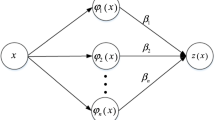Abstract
Reservoir sensitivity prediction is an important basis for designing reservoir protection program scientifically and exploiting oil and gas resources efficiently. Researchers have long endeavored to establish a method to predict reservoir sensitivity, but all of the methods have some limitations. Radial basis function (RBF) neural network, which provided a powerful technique to model non-linear mapping and the learning algorithm for RBF neural networks, corresponds to the solution of a linear problem, therefore it is unnecessary to establish an accurate model or organize rules in large number, and it enjoys the advantages such as simple network structure, fast convergence rate, and strong approximation ability, etc. However, different radial basis function has different non-linear mapping ability, and different data require different radial basis functions. Nowadays, the choice of radial basis function in the network is based on experience or test result only, which exerts a great adverse impact on the network performance. In this study, a new RBF neural network with trainable radial basis function was proposed by the linear combination of common radial basis functions. The input parameters of the network were the influence factors of reservoir sensitivity such as porosity and permeability, etc. The output parameter was the corresponding sensitivity index. The network was trained and tested with the data collected from our own experiments. The results showed that the new RBF neural network is effective and improved, of which the accuracy is obviously higher than the network with single radial basis function for the prediction of reservoir sensitivity.



Similar content being viewed by others
References
Zhang SH (1993) Reservoir protecting techniques. Petroleum Industry Press, Beijing
Li KX (1993) Drilling and completion techniques for reservoir protection. Petroleum Industry Press, Beijing
Baptist OC, White EJ, Land CS (1964) Laboratory predictions of water sensitivity compared with field observations of well damage-Patrick draw. SPE 839:1–8
Alegre L, Dougherty EL (1988) Applicability of expert systems to diagnose formation damage problems: a progress report. SPE 17460:559–570
Civan F (1992) Evaluation and comparison of the formation damage models. SPE 23787:219–236
Guo JM, Pu CS, Li Q, Chen Q (1996) A synergetic expert system for the identification, evaluation, diagnosis, prevention and treatment of formation damage. J Xi’an Petrol Coll 11(1):48–52
Wang B, Fang SZ (2002) Development of the formation sensitivity prediction expert system. Drill Fluid Complet Fluid 19(6):22–24
Baraldi P, Librizzi M, Zio E, Podofillini L, Dang VN (2009) Two techniques of sensitivity and uncertainty analysis of fuzzy expert systems. Exp Syst Appl 36(10):12461–12471
Civan F (2000) Reservoir formation damage-fundamentals, modeling, assessment, and mitigation. Gulf, Houston
Zhang XQ (2004) Gray evaluation of reservoir sensitivity. Petrol Geol Oilfield Dev Daqing 23(6):60–62
Liu BF (2008) Prediction of reservoir potential sensitivity on ultra-deep wells. Petrol Drill Tech 36(6):30–33
Jiang GC, Wang XJ, Wu XJ, Zhang WH, Hu CL, Xiong Y, He PX (2010) Application of pattern recognition in the prediction of reservoir sensitivity. Petrol Geol Recovery Effic 17(5):61–64
Peng CY, Yan JN (1997) Applications of artificial neural network in predicting formation sensitivity. Drill Fluid Complet Fluid 25(4):16–18
He SL, Tian L, Gu DH (2006) Improved neural network model predicts formation sensitivity. Drill Fluid Complet Fluid 34(1):28–31
Huang C, Jiang GC, Ji CF, Hu DL, Shen YQ, Song YG (2010) Research on the formation damage diagnosis based on radial basis functions neural network. J Basic Sci Eng 18(2):313–320
Jiang GC, Zhang WH, Wu XJ, Wang XJ (2011) Research on a new method for forecasting reservoir sensitivity. Comput Simul 28(9):322–326
Matuško J, Petrović I, Perić N (2008) Neural network based tire/road friction force estimation. Eng Appl Artif Intell 21M:442–456
Guo BS, Gong NS (2009) Trainable activation function RBF neural networks model. Microcomput Info 25(2):240–241
Jiang CH (1998) Neural network approximation. Ann Math 19A(3):295–300
Hu B, Gong NS, Huan HJ (2009) Improved learning algorithm of RBF network and its application in similarity. Comput Eng Des 30(18):4287–4289
Acknowledgments
This work is supported by the National Science and Technology Major Project of China (No. 2011ZX05009-005-03A) and National Science Foundation for Distinguished Young Scholars of China (No. 50925414).
Author information
Authors and Affiliations
Corresponding author
Rights and permissions
About this article
Cite this article
Wu, XJ., Jiang, GC., Wang, XJ. et al. Prediction of reservoir sensitivity using RBF neural network with trainable radial basis function. Neural Comput & Applic 22, 947–953 (2013). https://doi.org/10.1007/s00521-011-0787-z
Received:
Accepted:
Published:
Issue Date:
DOI: https://doi.org/10.1007/s00521-011-0787-z




